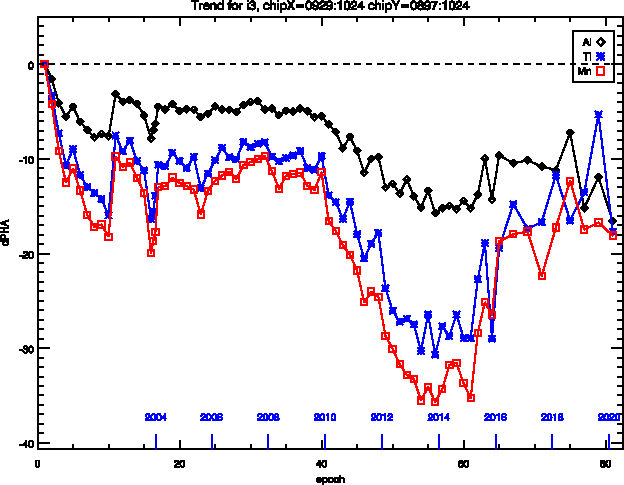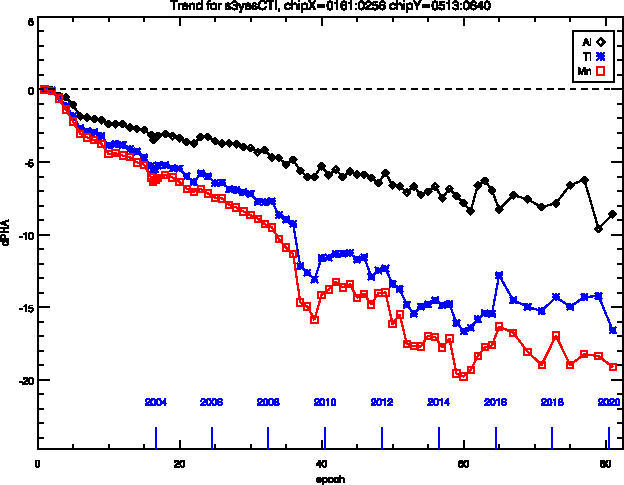CalDB 4.9.3 Public Release Notes
Public Release Date: 15 OCT 2020
SDP Installation Date: 2020-10-14T16:00 (UTC)
I. INTRODUCTION
CalDB 4.9.3 is an upgrade to the Chandra CalDB, which includes the following items:
For the CIAO 4.12.1 / CalDB 4.9.3 release notes see How CalDB 4.9.3 Affects Your Analysis.
II. SUMMARY OF CHANGES
A. ACIS T_GAIN Epochs 77-82
| Location: | $CALDB/data/chandra/acis/t_gain/ |
| Filenames: | acisD2019-05-02t_gainN0008B_revA.fits acisD2019-05-02t_gainN0008_revA.fits acisD2019-11-01t_gainN0008B.fits acisD2019-11-01t_gainN0008.fits acisD2020-05-02t_gain_biN0002.fits acisD2020-05-02t_gainN0002.fits |
The ACIS Calibration team has released new time-dependent gain correction data from the most recently complweted bi-epochal period, namely Epochs 81+82 (Feb-Jul 2020). With this release it is now possible to finalize the T_GAIN for the previous bi-epochal period (Epochs 79+80, Aug 2019 through Jan 2020). These updates are included in the files above with effecive dates 2020-05-02 (provisional) and 2019-11-01 (finalized) respectively.
As with recent previous epochs, the T_GAIN calibration continues to be challenged by the ever poorer statistics available from the ACIS External Calibration Source (ECS), which continues to decline in intensity as expected over time. However, a new data reduction method involving trend evaluation which considers a full year of ECS data to influence ("nudge") the semi-annual results, has produced considerable improvement in the latest data sets. The new technique was applied to the Epochs 77+78 period (Feb-Jul 2019) in addition to the bi-epochal periods above. Hence a "_revA" version of the previously-released 2019-05-02 T_GAIN files, and are listed above as well.
This release affects all ACIS observations taken since 2019-05-02T12:00:00, and users of any OBS_IDs with DATE-OBS later than that date are encouraged to reprocess their datasets. The degree of the corrections is similar to those of previous T_GAIN releases, and those analyzing narrow line-source data are the most likely to be affected signficantly. See the technical details section below for further information.
See the why page for a more basic explanation of the time-dependent gain correction.
PIPELINES/TOOLS AFFECTED:
ACIS Level 1 pipeline tool acis_process_events.
CIAO script chandra_repro uses acis_process_events to reprocess ACIS observation data.
THREADS AFFECTED:
Reprocessing Data to Create a New Level=2 Event File
B. HRC-I GTI_LIM for HV Ramp-Up Procedure
| Location: | $CALDB/data/chandra/hrc/gti_lim/ |
| Filename: | hrciD2020-09-28gtilimN0001.fits |
The recent HRC power supply anomaly aboard Chandra has required that the detectors be powered down so that the "B-side" electronics could be implemented. Power to HRC was then reestablished successfully, and most recently the HRC-I high voltage settings have been brought back up again. The procedure was completed over 2020-09-28 through 2020-09-29, with a manual procedure to "ramp up" the HV. The HRC instrument team requested that a modified GTI limits file be used for the data taken during the ramp-up procedure so that events could be delivered to L2 despite the GTI limits being applied. The modification was to removed the line from the HRC-I GTI_LIM file which includes the HV limits. A file with that prescription is listed above, and is to be effective in CalDB for only the period of 2020-09-28T00:00:00 until 2020-09-30T00:00:00.
PIPELINES/TOOLS AFFECTED:
In standard data processing (SDP) only, the tool mtl_build_gti, first run only for the "standard" GTI limits configuration, which is the only case in which the parameter lkupfile is actually set to "CALDB", so that the CalDB GTI_LIM file for HRC-I is actually delivered.
THREADS AFFECTED:
No CIAO threads are affected by this change.
III. TECHNICAL DETAILS
A. ACIS T_GAIN Epochs 77-82
The general description and method of derivation for the ACIS T_GAIN are given in the memorandum posted on ACIS Calibrationweb page http://cxc.harvard.edu/cal/Acis/Cal_prods/tgain/index.html. However, additional steps have been added to the derivation procedure, due to the ever poorer statistics that are attainable from the ECS due to the source's diminishing flux levels. In particular, the ACIS calibration team has used trends from previous epochs (when more ECS flux was available) to "nudge" their more recent results to provide more predictable time-dependent gain corrections. The method is to combine earlier epochal data with current (i.e. new) epochal data to generate a 12-month average for T_GAIN corrections, and use the trends form the 12-month averages to modify the 6-month averages, resulting in a smoother correction with better statistical support.
With these improvements in the epochs 81+82 dataset, R. Nick Durham of the ACIS Cal team elected to try applying the method tothe two previous bi-epochal periods, epochs 77+78 and 79+80, to generate updates to those periods as well for this release. Hence we are releasing the finalized epochs 79+80 T_GAIN files, as well as "revision A" of the finalized epochs 77+78 T_GAIN files, theoriginal versions of which had gone out in CalDB 4.9.1.
Long term trends for chips I3 and S3 are plotted below in Figures 1a and b, through Epoch 82, which includes the latest release. The chip locations for these plots are given in the respective labels above the plots. The chip locations selected are near the aimpoints. The full CTI corrections have been applied to the data in both figures. While some fluctuations have occurred recently in the results for the Ti and Mn lines of the ECS for I3 in particular, there is nothing out-of-expectation for the newest datasets. The fluctuations in the traces are due to counting statistics.
B. HRC-I GTI_LIM for HV Ramp-Up Procedure
Due to the HRC anomaly, and the switch to the B-side power system, the HRC HV has needed to be shut off and now re-established. The HRC-I startup procedure, including ramping up the high voltage to standard operational settings, was scheduled for late in the day of 2020-09-28, and was expected to into the early hours of 2020-09-29. The HV was to be adjusted via a manual procedure from the Ops Control Center during a DSN downlink period. The initial OBS_ID scheduled was OR 24644, which was to spawn ER 62650, which was to collect all events captured by HRC-I during the voltage adjustment procedure. These would be non-standard and non-calibrated events, and should not be included in an OR.
A GTI_LIM file with the high voltage limits specification deleted has been generated for CalDB to be valid only for the period 2020-09-28T00:00:00 until 2020-09-30T00:00:00. The line to be deleted from the ASCII limits table is as follows:
Row # gti_limits
--------------------------------------------------------------------------------
15 ((fabs(IMHVLV-80)<=1)&&(fabs(IMHBLV-87)<=1)
As such, the events data stored in OBS_ID 62650 are not all of reliable HV settings, and hence gain and QE values for those events outside of the calibrated HV range are not to be considered reliable. It is not possible to determine which of the events is affected, because GTI limits on the HV have been removed entirely from the procedures.

